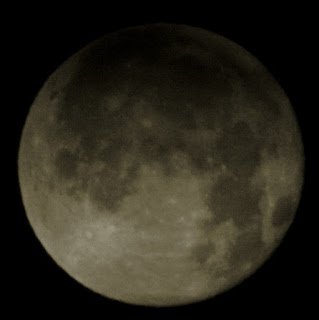November 29th 0630 GMT Moon
November 27th 2335 GMT
Betelguese and Meteor Hunt
It was clear after a cloudy and wet day
but very cold. I saw Betelguese and compared it with Procyon, Rigel and
Aldebaran. It was about magnitude 0.3.
I then set a camera to take 6 second
exposures at ISO 6400 and 18mm focal length.
I stacked ten early shots to show Orion and Canis Minor.
At 2350 GMT, I caught a bright meteor with a short trail and deduced that it was probably a Northern Taurid.
November 27th 2335 GMT Betelguese and Meteor Hunt
It was clear after a cloudy and wet day but very cold. I saw Betelguese and compared it with Procyon, Rigel and Aldebaran. It was about magnitude 0.3.
I then set a camera to take 6 second exposures at ISO 6400 and 18mm focal length.
I stacked ten early shots to show Orion and Canis Minor.
At 2350 GMT, I caught a bright meteor with a short trail and deduced that it was probably a Northern Taurid.
November 26th Moon Reprocess
I reprocessed another shot from November 3rd 2020.
November 26th Moon Reprocess
I reprocessed another shot from November 3rd 2020.
November 25th 0600 GMT Moon
I snapped the Moon in the morning before going to work, using my DSLR at 300mm focal length, ISO 100 and 1/160 second exposure.
November 23rd 0700 GMT Moon
November 22nd 2130 GMT Moon
November 22nd 1700 GMT Venus
November 22nd 0725 GMT Moon
November 21st 2000 GMT Moon
November 17th 2215 GMT Moon
The day was clearer than the day before but a mackerel sky accompanied the sunset and evening. I snapped the Moon at 300mm focal length, ISO 100 and 1/200 second exposure, as the evening before. I could not see Betelguese and there was no chance of seeing any meteors. The Moon was the only credible object.
November 16th 2235 GMT Moon and Betelguese
After a cloudy and wet day, it finally
cleared somewhat to reveal a waning gibbous moon. I snapped it at 300mm focal
length, ISO 100 and 1/200 second exposure.
Procyon was not visible but I was able to
see Rigel, Aldebaran, Pollux and Capella. It was hard to discern whether
Betelguese was as bright as Rigel, due to the difference in elevation.
Nevertheless, I estimated its magnitude at 0.2.
November 16th Moon Reprocess
It had been 5 days of hurt with no live actions so, I reprocessed a lunar image from February 2nd 2020.
November 15th Sun Reprocess
With persistent cloud continuing, I reprocessed a solar image from December 1st 2020.
November 14th Moon Reprocess
November 11th 1930 GMT Moon and Jupiter
I used a wider field of view (70mm focal length) and two different expoosues to catch the Moon with Jupiter.
November 11th Jupiter's Moons Shot Reprocess
November 10th Moon Shot Reprocess
I processed a lunar shot from September 1st 2020. as I had a few days of bad weather.
November 7th 1050 GMT Sun
Conditions were hazy but a large sunspot
was visible on the Learmonth images.
I increased my exposure time with my DSLR
and filter to 1/500 second.
November 5th 1050 GMT Sun
There was some thin cloud around but I
had a go at photographing the Sun
anyway with my DSLR and filters, using my
normal settings.
November 4th 2300 GMT Betelguese
Before bedtime, I saw that Orion had cleared the horizon. Procyon was not visible, so I used Rigel, Aldebaran
and Capella to estimate its brightness, so arrived at a magnitude of 0.3.
November 7th 1050 GMT Sun
Conditions were hazy but a large sunspot was visible on the Learmonth images.
I increased my exposure time with my DSLR
and filter to 1/500 second.
November 5th 1050 GMT Sun
There was some thin cloud around but I had a go at photographing the Sun
anyway with my DSLR and filters, using my normal settings.
November 4th 2300 GMT Betelguese
Before bedtime, I saw that Orion had cleared the horizon. Procyon was not visible, so I used Rigel, Aldebaran
and Capella to estimate its brightness, so arrived at a magnitude of 0.3.
November 4th 2015 GMT Meteor Hunt
November 4th 2000 GMT
I did a short photo shoot at 300mm focal length, ISO 6400 and 2 seconds exposure.
Targets were:
Jupiter’s Moons
Pleaides (M45)
Melotte 20
November 4th 1220 GMT Sun
November 2nd 2041 GMT Meteor Hunt
At 2240 GMT, I saw a "guest star". I zoomed in and found it looked like a broken trail. It is difficult to speculate what it was.
November 2nd 1230 GMT Sun
The Learmonth and Big Bear images were showing some small sunspots. I tried to catch them with my DSLR and filter set at 300mm focal length, ISO 100 and 1/2000 second exposure. However, I did not detect any.
November 2nd 0555 GMT Moon and Beletguese
I revisited the Moon and Betelguese, having followed them at times
during October.
The Moon was a thin waning crescent and I photographed it at 300mm focal
length, ISO 100 and 1/250 second exposure.

































No comments:
Post a Comment